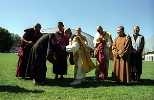A Buddhist monk of 20 years who received his Ph.D. in cell genetics from the Institut Pasteur described the relation of mental imagery to rigorous meditative practice in a talk that framed discussion over nearly three hours during a Saturday session of the conference on Buddhism and the biobehavioral sciences.
The monk, Matthieu Ricard, summarized the ways in which Buddhist meditation seeks to liberate the mind--and the emotions--from the very images neuroscientists now try to produce experimentally for study. He spoke to a crowd of 1,200 that included Hollywood stars Goldie Hawn and Richard Gere.
The Dalai Lama sat cross-legged in a white armchair at the center of the Kresge stage, with Buddhists and scientists on either side. The group of eight panelists included Nancy Kanwisher, professor of brain and cognitive sciences and an investigator at the McGovern Institute for Brain Research. Kanwisher invited the Buddhists on the panel to suggest what science should study about mental imagery.
Scientists and Buddhists found common ground in their fascination with where mental imagery comes from, whether it has intrinsic meaning and how mental images may be studied or controlled.
"Learning to stabilize mental images brings inner freedom. The technique of concentrating on an image of the Buddha seems artificial in the beginning, but the secret of genuine and lasting happiness is freedom from invasion of the mind by a stream of images," Ricard said.
Ricard addressed psychological processes by contrasting the Buddhist ideal of freedom from the "I," or self, with the Western value of personal identity. In fact, he said, "I don't visualize myself as a French monk with a big nose and a big belly, but as Buddha. That's when I started to progress."
Stephen Kosslyn, the John Lindsley Professor of Psychology at Harvard University, illustrated current neurological research on how the mind produces visual imagery by means of a quick quiz. "Do you know what shape a cat's ears are?" he asked the Dalai Lama.
The Dalai Lama consulted his interpreter, Thupten Jinpa, then burst into merriment. "What kind of cat?" he asked, clearly delighted.
Brain researchers and Buddhists also met in an exchange about the brain's image-building processes. They agreed a cat is normally visualized piece by piece, ear by ear, though it swiftly becomes a cat.
Only when a Buddhist contemplative "gains mastery does he see an image whole, complete as a fish coming out of water," said Ricard.
Whole images have inspired brain research, too. A researcher's sketch of a duck that might also be a rabbit showed the brain's tendency to cling to one constructed image over another. His Holiness, who spotted a duck in the ambiguous sketch, laughed when he saw the rabbit's head, too.
Ricard noted the Buddhist view of the duck-rabbit moment. "We strive to be aware of what we're visualizing. The more the mind is occupied by love, the less it is occupied with hatred. You can't shake a man's hand and beat him at the same time," he said.
A version of this article appeared in MIT Tech Talk on September 17, 2003.






